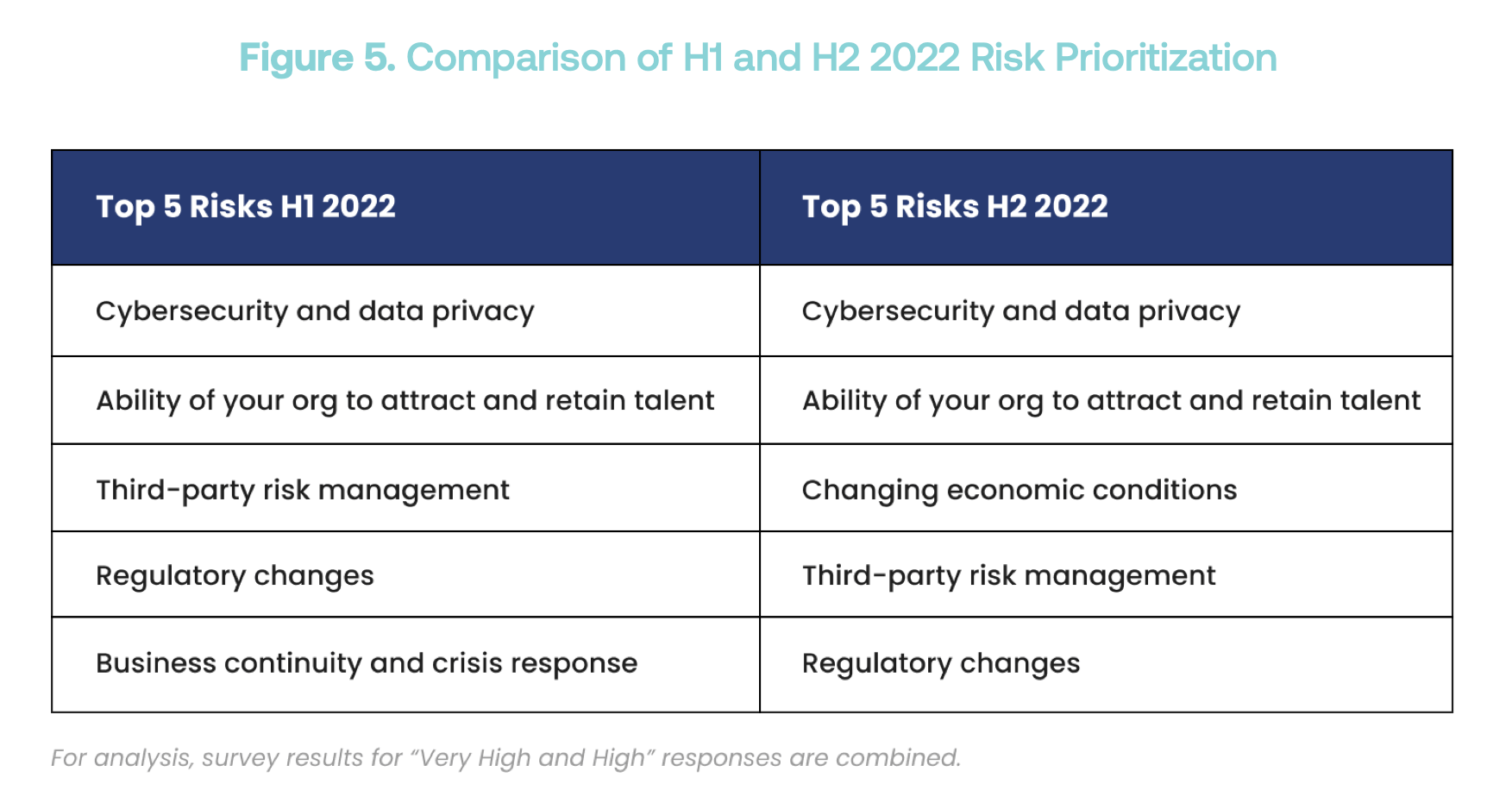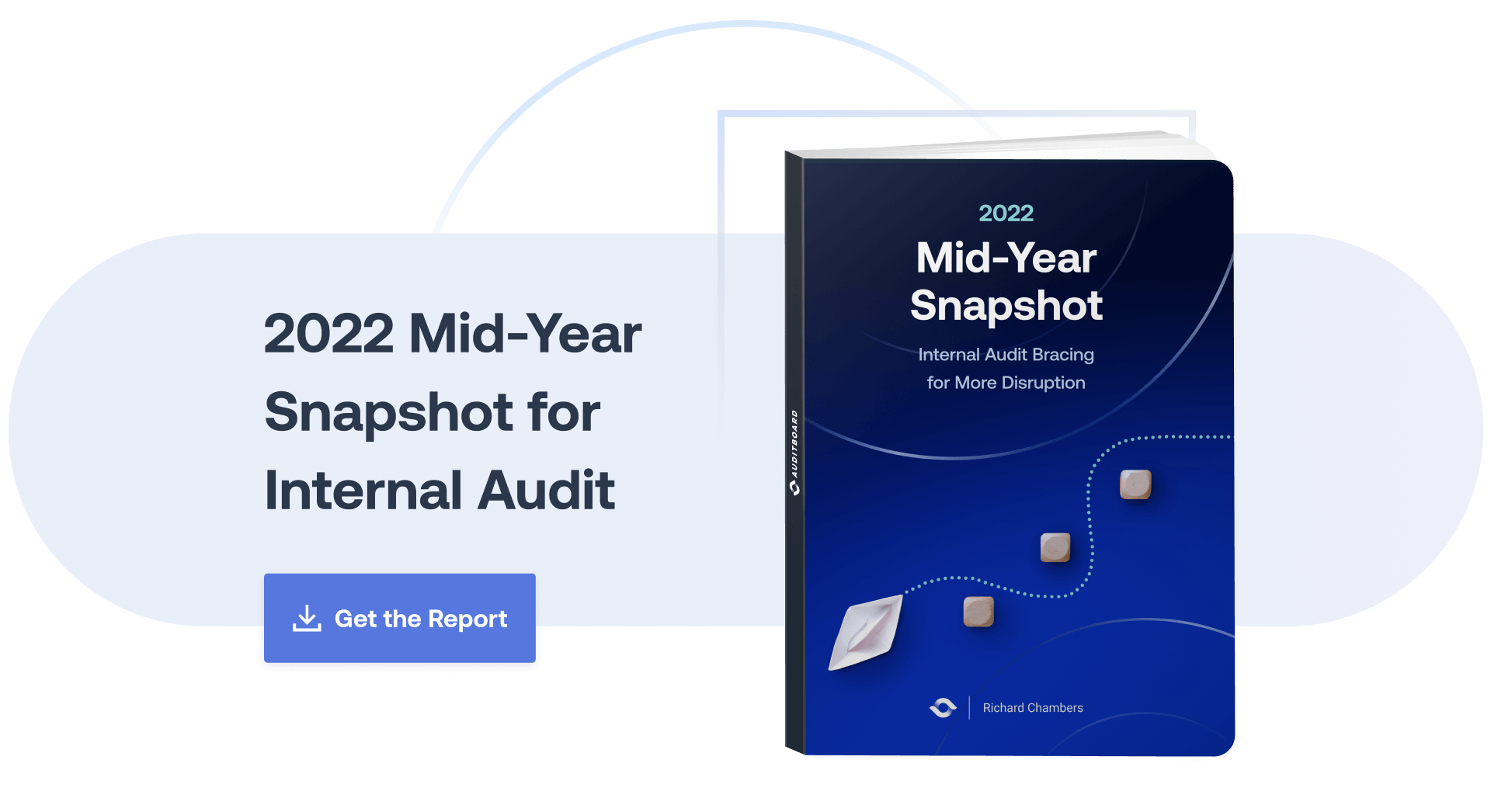
July 18, 2022 • 7 min read
Top Takeaways from the 2022 Mid-Year Snapshot Report
As we reach the midpoint of 2022, businesses continue to face unrelenting pressures in the face of new and emerging risks. Just as the COVID-19 pandemic seems to be loosening its grip on the world, we are thrown into geopolitical and economic instability, inflation at a 40-year high, historic staffing challenges, and now a likely recession.
This midyear update to Richard Chambers and AuditBoard’s 2022 Focus on the Future report is a continuation of our research into the most critical areas impacting internal auditors now and in the near future. It offers important insight from internal audit leaders into organizational risks in the second half of 2022 and into 2023, how the profession is adapting and evolving, and where improvements might be made. Read the top four takeaways from the report below and download your copy of the full 2022 Mid-Year Snapshot: Internal Audit Bracing for More Disruption report.
1. Resilience in the Profession Evident in Resourcing Plans
Internal audit departments were called to action time and again as the pandemic ebbed and flowed. Auditors showed great resilience and — according to the AuditBoard’s latest survey of 170 internal auditors in May 2022 — they are optimistic about the future. As organizations begin to return to pre-pandemic levels, 86% of internal audit leaders are maintaining or increasing budgets this year compared with 2021.

Internal audit leaders are also optimistic about the year ahead, with nearly a quarter of respondents forecasting increased budgets in 2023 and nearly a third planning for larger staffs. Increased budgets will likely fund additional staffing, travel, training, and investment in technology.
2. Anxiety Related to Attracting and Retaining Talent Raises Questions Over Strategy
Internal audit has not been spared from the Great Resignation. Like most other industries, the profession experienced a shake-up as many internal auditors faced work-life decisions, including a return to the office or traveling for work — as well as whether to pursue a new career track. In The Institute of Internal Auditors’ 2022 Pulse of Internal Audit report, the top reason cited for reductions in internal audit staff was “staff members voluntarily resigned.”
To counter the exodus and attract or retain staff, according to AuditBoard’s study, internal audit leaders said offering remote work (35%) and flexible working conditions (22%) proved most successful.

But as economic conditions evolve — including prospects for a recession — today’s successful strategies for talent recruitment and retention may have a short shelf life. In the long term, effective recruiting and retention most likely will rely on an array of options tailored to market conditions, as well as the individual and position.
3. Internal Audit’s 2023 Focus May Not Align With Most Significant Risks
Four of the five top risks cited by internal audit leaders for the second half of this year are identical to those cited in October 2021 as audit plans for 2022 were being compiled. To be sure, “changing economic conditions” is new to the top 5, but this change indicates a reactive approach since inflation started spiking in late 2021.

Further, when looking to 2023, internal audit’s focus may not align with the most significant risks facing their organizations. With the exception of cybersecurity, all other risk areas are prioritized differently. Talent management, regulatory changes, and business continuity are not even reflected in internal audit’s composite top five priorities.

Comparing the two perspectives of risks to the organization and the focus of efforts by internal audit, audit plans anticipated for 2023 may fall short of addressing several key risks such as talent management, a changing economy, and governance.
4. Confusion in the Chain of Command Over Budget and Focus Undermines the Appearance of Independence
IIA Standard 1110 requires that the CAE report functionally to the board to foster stronger organizational independence. The survey found that 8 of 10 do indeed report functionally to the Audit Committee or Board. On the other hand, there is less consistency in CAEs’ administrative reporting relationships. Survey respondents indicated they report administratively to the CEO (38%), CFO, (34%), or other executives (22%).

When asked who has the highest level of influence over internal audit’s budget, 52% indicated that the administrative reporting line highly impacts the budget compared to 27% who responded the functional reporting line has a high level of impact. These results would suggest that the administrative reporting line has a disproportionately high degree of influence on the internal audit team’s ability to execute its mission including the composition of the internal audit plan by controlling funding.
The findings of 2022 Mid-Year Snapshot: Internal Audit Bracing for More Disruption reveal an evolving internal audit profession pulled in many directions. For a deeper dive into the survey results and to learn how auditors can brace for the disruptive period ahead, download the full 2022 Mid-Year Snapshot report.
You may also like to read


Master your audit playbook: essential steps for internal audit teams

Top security audit software — cut fatigue & streamline workflows

Top headlines that defined 2025 for internal auditors

Master your audit playbook: essential steps for internal audit teams

Top security audit software — cut fatigue & streamline workflows
Discover why industry leaders choose AuditBoard
SCHEDULE A DEMO




